Ministry of Statistics & Programme Implementation
Release of Publication "EnviStats India 2025: Environment Statistics"
Posted On:
05 JUN 2025 7:15PM by PIB Delhi
The Ministry of Statistics and Programme Implementation (MoSPI), Government of India, released the 8th issue of the publication titled “EnviStats India 2025: Environment Statistics” during the National Workshop on Using Alternate Data Sources and Frontier Technologies for Policy Making on 5th June, 2025 in New Delhi.
Key highlights of the publication
- Thermal power generation has increased from 7,92,053 GWh to 13,26,549 GWh and Electricity generation from renewable energy sources has increased from 65520 GWh to 2,25,835 GWh during 2013-14 to 2023-24.
- Inland fish production has increased from 61.36 lakh tonnes to 139.07 lakh tonnes during 2013-14 to 2023–24
|
Since 2018, the National Statistics Office (NSO) has been publishing "EnviStats India" in alignment with the Framework for the Development of Environment Statistics (FDES) 2013. The data presented in the publication are compiled based on the data, sourced from various Ministries, Departments, and Organizations of the Government of India. Following the structure of FDES 2013, the data presented in "EnviStats India 2025: Environment Statistics" are organized into six components, each corresponding to the components of FDES 2013. Related topics under each component have been grouped together to facilitate easier understanding and use.
"EnviStats India 2025: Environment Statistics" is a key resource for policymakers, researchers, and stakeholders, offering a comprehensive overview of the country's environmental landscape. Through the analysis of key environmental indicators, the publication highlights emerging environmental trends, identifies pressing challenges, and supports the development of evidence-based policies aimed at achieving environmental sustainability and resilience. This year's publication introduced several changes in its formation and structure, which inter alia includes:
- An expert group comprising representatives from line Ministries/Departments and domain experts in the field of environment was constituted to consult on potential improvements to the publication, including expanding its scope, identifying potential data sources, and suggesting refinements in its design and presentation.
- The publication has been restructured to provide information in a component-wise format.
- The concordance of indicators collected for EnviStats 2025 was mapped vis-à-vis FDES 2013. The comprehensive list of indicators under the Basic Set of Environment Statistics from FDES 2013 is also included in the publication.
- New data on the population's access to electricity, transport, and sanitation is included. An indicator containing List of Ramsar Sites was compiled based on the Expert Group’s recommendations.
“EnviStats India 2025: Environment Statistics” is available at the website of the Ministry (https://mospi.gov.in/).
Important Highlights of the publication “EnviStats India 2025: Environment Statistics”
- The annual mean temperature increased from 25.05°C in 2001 to 25.74°C in 2024. Similarly, the annual minimum and maximum temperature rose from 19.32°C to 20.24°C and 30.78°C to 31.25°C respectively, during the same period.
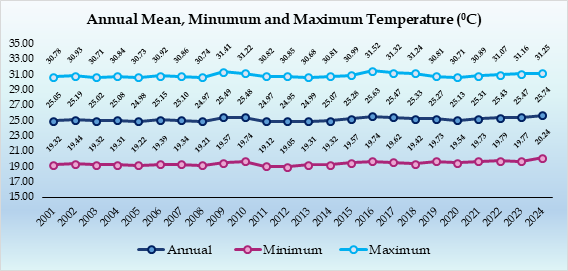
Source: India Meteorological Department, Ministry of Earth Sciences
- The annual rainfall data from 2001 to 2024 highlights significant year-to-year variability influenced by monsoon patterns. Despite this variability, the data does not indicate any clear long-term upward or downward trend in total annual rainfall.
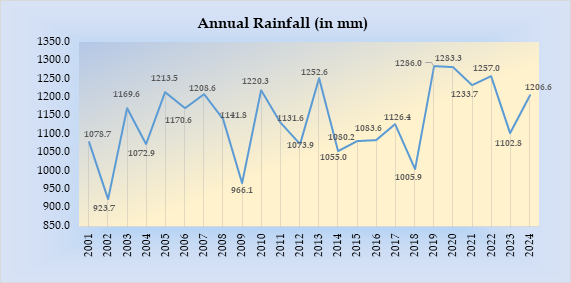
Source: India Meteorological Department, Ministry of Earth Sciences
- Globally, there are 2,47,605 marine faunal species, while India accounts for 20,613. India has 9,436 freshwater species, 5,023 species in the Indian Mangrove System, 3,383 species in the Estuarine Ecosystem, and a notable 22,404 species in its Soil Ecosystem. When considering the total count of faunal species, the world has 16,73,627 species of which 1,04,561 are found in India. This data underscores India's significant contribution to global faunal diversity across different habitats and high number of soil species in India is also noteworthy.
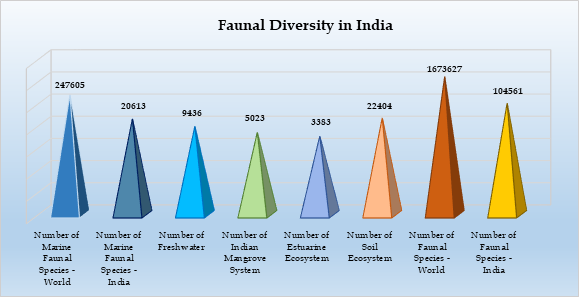
Source: Zoological Survey of India, Ministry of Environment, Forest & Climate Change
- Inland fish production has increased from 61.36 lakh tonnes in 2013-14 to 139.07 lakh tonnes in 2023–24, possibly indicating inland aquaculture and freshwater fisheries. With a slower growth, Marine production has also increased from 34.43 lakh tonnes to 44.95 lakh tonnes during the same period.
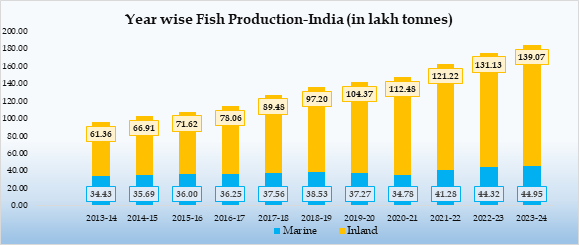
Source: Ministry of Fisheries, Animal Husbandry and Dairying
- The Environment Sustainability Sector shows the highest expenditure share as Rs. 2433.24 crore in 2021-22. The Conservation of Natural Resource Sector shows an upward trend and the Agro-Forestry Sector exhibits the lowest expenditure among the three sectors: Agro-Forestry, Conservation of Natural Resources, and Environment Sustainability.
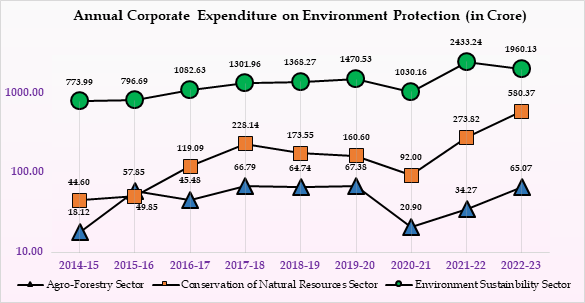
Source: Ministry of Corporate Affairs
*****
Samrat/Allen
(Release ID: 2134312)